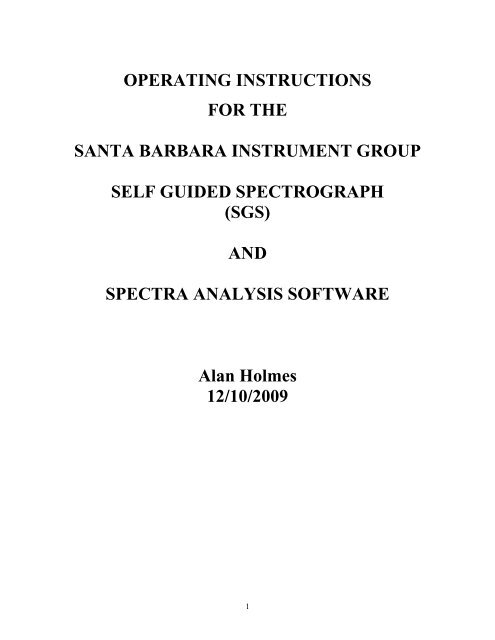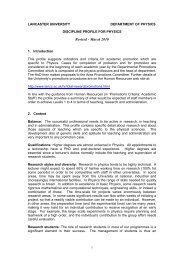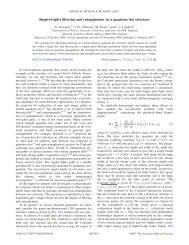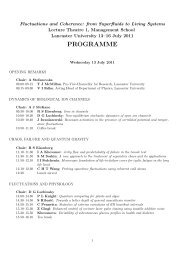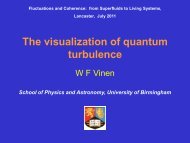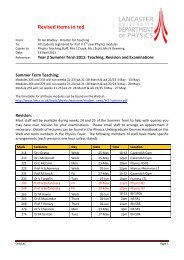SBIG Self Guided Spectrograph (SGS) Operating ... - Sbig.com
SBIG Self Guided Spectrograph (SGS) Operating ... - Sbig.com
SBIG Self Guided Spectrograph (SGS) Operating ... - Sbig.com
- No tags were found...
Create successful ePaper yourself
Turn your PDF publications into a flip-book with our unique Google optimized e-Paper software.
and K lines to H-Alpha with a single exposure. The resolution is about 8 angstroms. Ahigh resolution grating on a carousel in the instrument can also be used that gives 1.07angstrom per pixel dispersion, with a resolution of about 2.2 angstroms. The spectralrange is smaller, being only about 750 angstroms. This resolution is adequate to detectthe doppler shift due to the earth’s motion around the sun when carefully calibrated, anddetect spectroscopic binaries.Two slits are provided with the unit. The slit installed at <strong>SBIG</strong> is 25 microns wide, but itappears to be 18 microns wide to the spectrograph since it is tilted. A wider slit, 100microns wide, is included with the spectrograph for use in capturing the spectra of dimextended objects, such as galaxies. It appears to be 72 microns wide. It is more effectiveon dim objects since more light makes it through the slit, but at the cost of spectralresolution.3.0 <strong>SGS</strong> Specifications:Dispersion: 1.07 or 4.3 Angstroms per pixelResolution: emission line is recorded with 2.2 or 8 Angstrom Full Width at HalfMaximumSpectral coverage per frame: about 750 Angstroms with the high resolution grating, or3200 Angstroms with the low resolution gratingCenter Wavelength Selection: Calibrated Micrometer AdjustmentWavelength Range: 3800 to 7500 AngstromsSensitivity: Signal to noise ratio of 10:1 for a 10 th Mag star, 20 minute exposureusing an ST-7E and a 10 inch (25 cm) aperture in high resolutionmode. An ABG ST-7 will reach magnitude 8. The low resolution modewith the wide slit will be 2 magnitudes more sensitiveEntrance Slit: 18 micron (2.3 arcseconds wide with 63 inch (160 cm) focal lengthTelescopeAcceptance Angle: F/6.3 by F/10. F/6.3 re<strong>com</strong>mended for maximum signal.Dimensions: 4 x 5 x 8 inches (10 x 12 x 20 cm)Weight: spectrograph plus ST-7 weigh 5.2 pounds (2.4 kg)Uses:Stellar ClassificationAnalysis of Nebular LinesIdentification of spectroscopic binariesMeasurement of Stellar proper motion to +/- 6 km/sec accuracyMeasurement of Emission Nebula Proper MotionsSpectra of Laboratory and field sources3
Galactic Spectra and Red ShiftMeasurement of Brighter QuasarsGalactic Red Shifts and Spectra: Difficult to obtain due to faintness, extended nature ofsource, and lack of high contrast emission lines. Only the brighter galaxies can bemeasured. Seyfert galaxies which have excess H-alpha emission are much easier tomeasure.4.0 Initial Alignment - All <strong>SGS</strong> units that are shipped from <strong>SBIG</strong> have been aligned to anST-7 camera here, so they should be pretty close. If you find during one of the followingsteps that the system appears to be seriously misaligned, make sure no optical elementshave <strong>com</strong>e loose and that you are following the procedure correctly.Step 1 – Attach Coupling: remove the D-block from the front of your ST-7 or ST-8.Using the four screws provided, attach the spectrograph coupling to the ST-7 asillustrated in Figure One. It is important to orient the coupling as shown, with the thickpart to the left.Figure One:ST-7 with Attached Coupling – Note Orientation<strong>Spectrograph</strong>CouplingStep 2 – Attach camera to <strong>Spectrograph</strong>: remove the cover on the spectrograph byremoving the four Phillips Head screws around the periphery of the baseplate. Loosen4
the clamp where the camera attaches, and insert the tube on the coupling. Lay the cameraon its back when retightening the clamp to insure that the camera is fully seated. Thecamera should be oriented so the exiting cables point away from the end of thespectrograph with the toggle switch. Figure Two labels the important <strong>SGS</strong> alignmentpoints.Note: if you are using an ST-8 you will need to reposition the clamp plate to theother set of holes in the baseplate. This will maintain the tracking CCD at the originalposition, but move the imaging CCD over. Due to the larger size of the imaging CCD,the spectra will still fall uponit.Figure Two: Important Alignment PointsTelescope CouplingFocus AchromatSpherical MirrorGratingToggleSecond FoldMirrorGratingLeverCamera ClampMicrometerScrewStep 3 – Adjust slit focus: slip the cover back on, without the screws (you get to do this alot), and connect the camera to your <strong>com</strong>puter. Power it up, and run CCDOPS. With theassembly just sitting on the table, select FOCUS mode with the tracking CCD and adjustthe room light so you can see the slit with a 1 second exposure. Power up the internalLED by flipping on the toggle switch. The slit should be approximately vertical, and inthe center third of the tracking CCD. In this step, you should adjust the slit focus to besharp – do not worry about the orientation to the CCD grid. Make sure the flag on top ofthe cover is oriented so as to let the light go by.When you can see the slit image, adjust the focus by removing the cover,loosening the focus achromat, moving it slightly, retightening it, and reinstalling the5
cover. Continue with this process until the slit image is sharp (1 to 2 pixels wide). Thisis tedious, but need only be done once. The image file on the software disk,M57TRACK.ST7, shows what an acceptable focus looks like.Step 4 – Adjust slit image position: to center the slit on the tracking CCD, loosen thesecond fold mirror, rotate it slightly, retighten it, replace the cover and view the image.The adjustment is coarse. Once again, this is a tedious process. If the slit image is on thecenter third of the tracking CCD you are done. This <strong>com</strong>pletes tracking CCDadjustments.Step 5 – Find spectral lines: set the assembly on the table, resting on the handles. Tape apiece of paper over the telescope coupling, and illuminate it with a fluorescent lamp or aneon lamp. Choose the low resolution grating by rotating the toggle to point up (awayfrom the handles) until it snaps into the detents. Set the micrometer screw to 5.44 mm(which should put the mercury 5461 angstrom line near the center). Orient the flag ontop to block the tracking path since the light flood-illuminates the slit. In CCDOPS setthe CCD to imaging, the resolution mode to 1xN, and the vertical binning to 4 pixels.Use focus mode with the imaging CCD, 1 second exposures, and you should see spectrallines. The cameras are shipped with the low resolution grating in position. Refer toFigure Three for identification of the most prominent spectral lines for mercury and neon.Figure Three: SPECTRA program Illustration of Spectral Lines (Low Dispersion)6680 64035851NeonMercury5770 &5791546143584046Note: the camera can have very significant stray light when used this way, sincevery little light goes through the slit: most bounces off the reflective surface and ends upon the tracking CCD, where it can scatter to the imaging CCD. Astronomically this isonly a problem when doing the moon or sun – all other sources are fairly small.Fortunately, the sun and moon do not need self guiding! This is the purpose for the flagon top of the cover. If self-guiding is not needed (generally for a spatially large source)block the tracking path.Step 6 – Rotate camera: Once you have spectra, switch to the high resolution grating andcenter a bright line. In the high resolution mode the spectral line should be nearlycentered when the dial reads the wavelength. For example, a dial reading of 5.46 mmshould position the 5461 angstrom line on the CCD. The dial reading is not perfect in thehigh resolution mode, but its good enough to find isolated spectral lines.The vertical binning really accentuates the slant of the spectral lines, but the slantis easily removed. Remove the cover, loosen the camera coupling and rotate the camera6
slightly, retighten the coupling, and slip the cover back on. We re<strong>com</strong>mend you lay thecamera on its back while doing this to ensure the camera is seated. Repeat this processuntil the spectral lines are vertical to within a pixel, which is not that hard. Don’t worryabout momentarily blocking the fan while tightening the clamp – no harm will be done.Note: we align the spectrograph at <strong>SBIG</strong> such that when the spectral lines arevertical in the high resolution mode, a stellar spectra will be horizontal to an accuracy ofa few pixels. This is only true in the high resolution mode. If you switch to the lowresolution mode the stellar spectra will still be horizontal, but the calibration lines will tiltto the right about 15 pixels, top to bottom. At this point you have a choice. If you wishto work in low resolution mode you can live with the tilt, but calibrate on exactly thesame strip that the star falls upon. This is re<strong>com</strong>mended in practice. Or, you can rotatethe camera to make the calibration lines vertical, and live with the tilt of the stellarspectra which, if you are binning 4:1, isn’t too bad. If the source is an extended objectthis is not much of a problem. The inability to perfectly square up stellar spectra withcalibration lines is a consequence of the optical design. We have rotated the slit slightlyoff horizontal to minimize this effect for the high resolution grating, assuming that themost critical wavelength position determination will be done with this grating.Step 7 – Focus the <strong>Spectrograph</strong>: Reach underneath the spectrograph and loosen thescrew that clamps the spherical mirror assembly down. While viewing a bright, centeredline using CCDOPS, focus the spectrograph using the focus screw, which translates themirror toward or away from the grating. When satisfied with the focus retighten themirror clamp screw. Check again. Clamping the screw shifts the focus slightly so, whenyou get close, you may need to clamp each time you move the mirror.Both gratings focus at the same point. Since the design uses only mirrors, alllines are in focus.Step 8 – Calibrate the micrometer: Find the bright mercury line at 5460.7 angstroms andcenter it on the imaging CCD using CCDOPS. Switch to the high resolution grating byflipping the grating lever to where it points toward the handles. You should feel thedetent as the grating snaps into place. Adjust the micrometer to read 5.46 mm. Using theadjustment screw on the grating lever, adjust the grating angle to where the 5460.7 nmline is recentered. Once again, this is tedious since the cover has to be repeatedlyremoved and replaced. Once adjusted, tighten down the locknut on the adjustment screw.Try finding other lines by dialing the micrometer. While the micrometer accuracy is notperfect, it enables you to rapidly find a spectral region. When the low resolution gratingis used, we re<strong>com</strong>mend you construct a simple calibration table of center wavelength as afunction of micrometer reading (using known spectral lines) to aid you in positioning thegrating. As an aid, the following table shows where the <strong>com</strong>mon mercury lines will befound with the low resolution grating when the high resolution grating is calibrated.Line Micrometer4046 A 5.104358 5.155461 5.445770&5791 5.527
Step 9 – Finish: tighten all screws, and replace the cover. You may find that longexposures require you to seal the joints with black electrician’s tape to prevent lightleaks, depending on the light level in your observatory. Light leaks are most likely tooccur around the camera-spectrograph connection, on the bottom side of thespectrograph. Make sure you leave the internal LED off during a long exposure (Iguarantee you’ll forget at least once)!Optional step – Installation of the wider slit: remove the cover, and locate the slitassembly. Remove the LED bracket from the slit, and set it down out of the way insidethe unit. Remove the two slit mounting screws while holding the end of the slit plate,remove the slit, and install the wider slit plate. (It is easy to identify the wider slit byholding it up to a light). Press the slit plate toward the baseplate when finally tighteningthe screws to preserve the factory alignment. Make sure the aperture side of the slit facesthe telescope. Re-attach the LED bracket. Re-install the cover. No other alignment ofthe unit should be necessary except, of course, the wavelength calibration. It will onlychange slightly.5.0 Use of the <strong>Spectrograph</strong>If you are new to using the ST-7/8 camera we suggest you refer to its manual and have afew practice sessions using it as an imager before attempting collecting spectra.To collect a spectrum of an object, first position the telescope to place the object on thetracking CCD using CCDOPS. Turn on the internal LED to backlight the slit andposition the object onto the slit. The LED brightness can be adjusted by turning thepotentiometer shaft. For bright stars, you will see multiple images, displacedhorizontally. This occurs at the slit. It can be hard to recognize which image is the mainone since CCDOPS auto-contrasts the images. If in doubt, broaden the range of thedisplay contrast, and then the brightest image is obvious. When the object is placed onthe slit, go to the camera setup menu, and select the imaging CCD, 1xN resolution, and avertical binning of 1x4 (for stars) or 1x8 (for dim extended objects). Immediately start aself-guided exposure with the desired exposures set for tracking and imaging CCDs.When the first image appears select the star, view the image to make sure the object isstill on the slit, carefully turn off the LED back-light, and start the exposure. Save theimage when done.Positioning the object on the slit can be tricky. The CCDOPS for DOS softwarehas an option when beginning self-guiding to track-to-the-cursor or to-the-centroid of thestar. Tracking to the cursor enables the user to reposition the star slightly to straddle theslit. CCDOPS for Windows may have this feature also by the time the user acquires thespectrograph.You will need to take darks just as for imaging, captured using the same vertical binningas the spectra. The darks are more critical, since there is very little sky background whendoing spectroscopy, and the noise in the image is dominated by the dark current. In long8
exposures cosmic rays are a nuisance, leaving bright pixels in the light images and darkstreaks if in your darks. <strong>SBIG</strong> has received much criticism that our temperaturestabilization is faulty and the darks taken on separate nights do not subtract well. I haveinvestigated this problem and found that darks on separate nights indeed do not subtractwell, but it is not a temperature stabilization problem. It is as if something changes in theCCD slowly over time, and does not repeat over long periods. I re<strong>com</strong>mend the userplan on taking long darks to match the exposures on the same night the spectra arecollected. This will give the best results. Libraries of darks do not work well.To collect a calibration spectra, position the calibration lamp to illuminate the opaldiffuser on the bottom of the spectrograph and take an exposure long enough to get atleast a few hundred counts of signal in each line. You should do this either directlybefore or after capturing the astronomical spectra, without removing the spectrographfrom the telescope or disturbing it significantly. We have tried to make a very solid unit,but measuring line position to an accuracy of fractions of a pixel requires great care. Forvery critical work, such as measuring doppler shifts with high accuracy, we re<strong>com</strong>mendyou collect the calibration data simultaneously with the astronomical data. This is doneby placing the light source several feet away from the diffuser, and leaving it on duringthe exposure. A fluorescent lamp will not work for this technique since there is so muchcontinuum. You will need either a mercury or neon lamp. The biggest problem is notscale changes, where the dispersion of the system in angstroms per pixel changes duringan exposure, but simple shifts. For this reason neon lines, even though they areinconveniently placed in the yellow and red, are useful. After the exposure one can use afluorescent lamp to measure the scale factor. Try to position the spectral region underobservation such that one can obtain at least two calibration lines.There is no perfect calibration source <strong>com</strong>mercially available. Small neon indicatorlamps positioned close to the diffuser work well for the red and yellow end of the spectra,but have nothing in the green and blue. Mercury (which is used in fluorescent lights) isthe best easily available lamp source for this region. If your site is significantly lightpolluted you will see mercury and sodium lines in long exposure data, along with anairglow line at 5577 angstroms. Sodium absorption lines in galaxies are very useful fordoing red shifts, so sodium lines in the sky background are quite annoying. The analysissoftware enables one to remove the bulk of the light pollution signal from the data.6.0 Use of the Analysis Software<strong>SBIG</strong>’s WINDOWS 95/98 analysis software enables one to view the collected spectragraphically, to calibrate the spectra, to print out graphical data, and to produce text fileswith the raw data annotated with wavelength data. These text files can be viewed withpopular spreadsheet programs, which have more powerful graphing capability. Thecalibration that is performed is a best fit to the grating equation using two lines, and isgood to about 0.1 pixel with adequate signal.To install the software, install the floppy disk labeled DISK 1 into your PC, and run thesetup program. The setup utility will install the program and some sample files.9
If you run the program you will see the user screen shown in Figure 4. You should beginby loading a calibration spectra. Start by clicking on the LOAD CAL button, and loadthe MERC.ST7 spectra. This spectra was obtained by capturing a mercury spectrum inlow resolution mode. The <strong>SBIG</strong> Spectra program will only load files that are less than768 pixels wide and exactly 20 pixels tall, so the data was cropped to that shape. Next,click LOAD DATA and load the NEON.ST7 data. Reselect the calibration data byclicking the GRAPH CAL button.Once the data is loaded you can click the ADJUST CONTRAST button to bringup a dialog box that allows you to modify the background and range with which theimage is displayed. The analysis program uses the values that were saved with theimage, so if you get in the habit of adjusting the appearance before first saving the imageyou will save time.Using the long horizontal scroll bar underneath the graph, move the red tickbetween the two spectral strips over to the line at 5460.7 nm (refer to Figure 3). You canmove the tick by either clicking on the ends of the scroll bar, or putting the mouse on theslider between them, holding down the left button, and dragging it back and forth. Centerthe spectral line between the two vertical lines on the graph. These two vertical linesshould be spaced to <strong>com</strong>fortably enclose 95% of the signal in the spectral line, but not sofar apart that neighboring spectral lines are included. The line spacing can be changedusing the SELECT WIDTH OF REGION control on the right side of the screen. Clickthe down arrow, and choose the desired width from the options by clicking on it. Theline spacing should change on the graph. Five pixels wide is a good choice for theexample.With the 5460.7 nm spectral line centered, click MARK LINE 1. The softwarewill then find the centroid of the spectral line to accurately determine its position. Next,move the red tick mark to center the line at 4358.337 nm. Use the IDENTIFYSPECTRAL LINE control to select 4358.337 nm. Click MARK LINE 2. The softwarewill <strong>com</strong>plete the calibration and display the calculated focal length of the sphericalmirror in the spectrograph, and the spectral dispersion across the CCD in angstroms perpixel. The dispersion is an approximation – the software uses the grating equation everytime it calculates a wavelength to minimize calculation errors. The focal length is about140 mm, and the dispersion 480 angstroms per mm (ignore the sign).You are now ready to measure a spectra. Click the GRAPH DATA to look at theneon data. Move the red tick over to a line, center the line, use the CALCULATE LINEWAVELENGTH control to view the line’s wavelength (this control uses the centroid ofthe data for accurate results). If the value is slightly off, select the correct wavelengthfrom the IDENTIFY SPECTRAL LINE box, and hit MARK LINE ONE. Since theprogram has an active calibration it keeps the focal length parameter from before, andadjusts the grating angle to <strong>com</strong>pensate for the slightly different position in the neonspectra. Now, move the red tick mark over to the other spectral lines visible in the ringnebula image, center them, and click CALCULATE LINE WAVELENGTH on the leftside of the screen. The software will find the centroid of each line, and use the gratingequation to find the true wavelength.10
Note that the border around the upper strip image is red. Click the GRAPH CALbutton to bring the calibration data back to the graph. Now if you center a line in thegraph, and click CALCULATE LINE WAVELENGTH you will see the centerwavelength of a feature in the calibration data. The calibration will still use the 5460.1nm line centroid value from the neon data, though, so you need to recenter the 5460.7 nmline in the calibration data, and click MARK LINE 1 again.The CALCULATE LINE WAVELENGTH button works with absorption featuresalso. The software first looks to see if the center pixel is less than or greater than thepixels marked by the lines to determine if it is an absorption feature or emission feature,respectively, and then calculates the centroid appropriately.The LINEAR GRAPH, LOG GRAPH, AUTOSCALED GRAPH, and PUSHEDGRAPH all affect the way the data is graphed in the graph box. For LINEAR GRAPHthe data is simply scaled from the minimum to the maximum of the data set. For LOGGRAPH each factor of 10 in counts is scaled to one quarter of the graph box’s range. ForAUTOSCALED GRAPH, which is the most useful, the data is linearly scaled from themaximum to the minimum of the portion of the spectrum within the graph box. ForPUSHED GRAPH the data is shown at maximum scale so features down in the noise canbe seen.If you check the SMOOTHING ON box, the graph will be smoothed for displaypurposes. If you click EXPAND SPECTRA, the gray scale display for both data andcalibration spectra will be displayed expanded vertically. Any slope in the lines isremoved, and faint features (real or not!) are more easily seen. If a calibration is active,the displays will be shown in color, matched to the spectral data.Controls for cropping the calibration and data spectra are contained in the lowerright and left corners of the screen. If these controls are left at their default, 1 to 20, thenall 20 pixels in a column are summed and that data used for all calculations. You canadjust the crop box to include only that portion of the spectra which contains stellar data.This is a convenient feature. For example, collect some data on a star or nebula with thecalibration source on during the exposure. Crop the data to 768x20 and resave it. Loadthe file into both the calibration and data spectra screens. Crop the CALIBRATION datato just include the calibration lines above the object’s spectra, and crop the DATA spectrato just include the object. Cropping is useful when the calibration data is captured at thesame time as the astronomical data, such as this. It can also improve the signal to noisewhen very faint stars are being observed, when including all 20 pixels in a column whenonly 4 have signal will increase the noise. Note – when moving the crop limits, thedisplay takes several seconds to update.The FILTER AIRGLOW control can be used when the crop lines are moved offthe boundaries into the body of the strip. It subtracts off the airglow, based on what isabove or below the crop box. The USE MEDIAN control reduces noise by applying amedian filter to the data. The median filter works well since the noise is mostly “hotpixel” in appearance.To print out a graph of the spectrum for annotation or future reference, click thePRINT GRAPH button. To write a text file containing the sum of the signal between thecrop lines, use the WRITE TEXT FILE button. The file created will be saved in the samedirectory as the original file, with a .TXT extension. If a calibration is active thewavelength data will be shown for each pixel. This text file can be opened with11
Microsoft Excel or other spreadsheet programs. The data saved will be for the activestrip.The SAVE STRIP FILE <strong>com</strong>mand creates a .ST7 file of the expanded spectra forprocessing by CCDOPS with the intent of creating a publishable illustration. One canalso sample the screen image at any time by hitting the ALT-PRINT SCREEN keys onthe PC keyboard, which copies a bitmap of the screen into the clipboard. One can thenPASTE the image into PAINT, or other programs, where it can be manipulated.If you need to calibrate using spectral lines that are not part of the list, please usethe MANUAL ENTRY option at the bottom of the spectral line list. Then enter thewavelength of the calibration line in Angstroms in the dialog box that pops up.Version 1.2 of the SPECTRA software should read ST-7/8/9/10 images up to 768pixels wide and 20 pixels tall. Users with ST-8s and ST-10s should <strong>com</strong>press theirimages 2x2 and crop them, if necessary. The software should correctly account for thelarger pixel size of a binned image.7.0 Collecting Astronomical SpectraTo gain experience with the device and the software, we re<strong>com</strong>mend you start outmeasuring some bright stars in both low resolution and high resolution mode, and somebright nebulas in low resolution mode. With the stars you will find that red stars, such asBetelgeuse, Arcturus, and Antares have copious spectral lines. These lines need the highresolution mode to fully resolve them. Easily identified lines are the magnesium triplet at5167.328, 5172.698, and 5183.619 A, and the sodium doublet at 5889.973 and 5895.940A. Bright blue stars, such as Sirius, Vega and such have much less distinct lines, buthave broad absorption features around H-alpha (6562.808 A), H-beta (4861.342 A) andH-gamma (4340.475 A). Note that the breadth of these features is different between starsof different temperatures. Stars with hotter coronas have broader features (Dopplerbroadening).With nebular data, you should have no problem finding H-alpha, H-beta, andatomic oxygen (5007 A) lines. Faint diffuse objects are easy if the spectrum is <strong>com</strong>posedof emission lines.For a greater challenge, try measuring the orbital velocity of the earth by lookingat stellar data with high resolution. The Doppler shift is only about a pixel, so themeasurement requires care. You can find published data on stellar velocities in a numberof publications (such as Astrophysics Quantities). Trying to match published data withstellar data from stars in different parts of the sky will reveal the motion. The correctanswer is that the earth is moving at 30 kilometers per second in its orbit. If you standoutside at sunset, and look toward the celestial equator in the south, you are movingAWAY from what you see, and the lines will be shifted to the red. Note – the movementis not directly toward the celestial equator, since that is defined by the rotation axis of theearth, not the axis of the earth’s rotation around the sun.The red shift of a spectral line in angstroms is well approximated by the followingequation:Red shift = Z = (wavelength observed-wavelength actual)/(wavelength actual)12
Z = velocity/C, where C = 300000 km per second (for non-relativistic speeds)Objects moving away from you are shifted to the red. Our position in the spiral arm ofthe Milky Way results in a 215 km per second imposed on objects outside the galaxy,depending on their direction relative to the galactic equator (which is quite tilted relativeto the celestial equator). Velocities of remote galaxies are sometimes given relative tothe center of the Milky Way, so use reference publications carefully.When you are <strong>com</strong>fortable with the unit, you can attempt measuring galactic redshifts. Galaxies are hard since they are faint, extended, and mostly have a continuumspectra. Capture some spectra in low resolution mode with the wide slit and longexposures, such as 10 to 20 minutes, with multiple exposures. One usually does not needa calibration lamp on during the exposure since light pollution and natural airglow lineswill be recorded, but at a low level. It is much easier to measure red shifts for Seyfertgalaxies, which have an excess of H-alpha and show emission lines, than other galaxies.Even the knots of H-alpha in galactic arms may be easier than the core. Take aconventional CCD image with an H-alpha filter or red filter to reveal the H-alpha regions,which can then be positioned on the slit. They are difficult to see on the tracking CCD,and may require that you estimate where they are from the galaxy core and nearby stars,and put the desired part of the sky on the slit. On trick is to rotate the spectrograph sothat the slit runs through both the core and the H-alpha region, so you can improve yourchances of hitting it. While rotating the spectrograph-camera <strong>com</strong>bination is not thateasy, neither are one hour exposures. If you are capturing spectra of galaxies with littleH-alpha, look for the sodium doublet absorption feature to detect red shifts, and <strong>com</strong>pareit with spectra of M0 stars. The older red stars that <strong>com</strong>prise most galaxy cores show thesodium feature. Do not bother with high resolution since the random motion of the starswithin the galaxy blur the spectral features to several angstroms wide anyway.M82 is a bright galaxy with a small red shift but copious H-alpha and very highvelocities in its core. It is a good initial target with the narrow slit to see thedisplacements of the spectral line across the core.Quasars can be detected. Their spectra approximates a galaxy with superimposedemission lines. Fortunately their energy in spectral lines is great so, while they are faint,their red shift is more easily measured than galaxies.8.0 Parting CommentsThe field of amateur spectroscopy is quite new. Only now is equipment <strong>com</strong>merciallyavailable to make measurements of stellar spectra, radial velocity, and emission nebula.As a result there is a shortage of publications that help the amateur interpret the spectraobtained, and plan interesting observing programs. The popular magazines are beginningto fill this shortage, working in conjunction with the advanced amateurs using ourequipment. As the discipline matures we will strive to build the capability into ourequipment that is needed, for presently we too have limited knowledge of what theamateur requires. Good luck!13
P.S. - Calibration Lamps – I’ve used the Edmund H71559 Power Supply ($160) andsome spectral tubes (Mercury = H60908, and Neon = H60910, each $24) as calibrationsources – they work well and the price is reasonable. They also have hydrogen tubesavailable. Also, our web site, sbig.<strong>com</strong>, contains more information on the spectrograph,including some example astronomical observations.14


